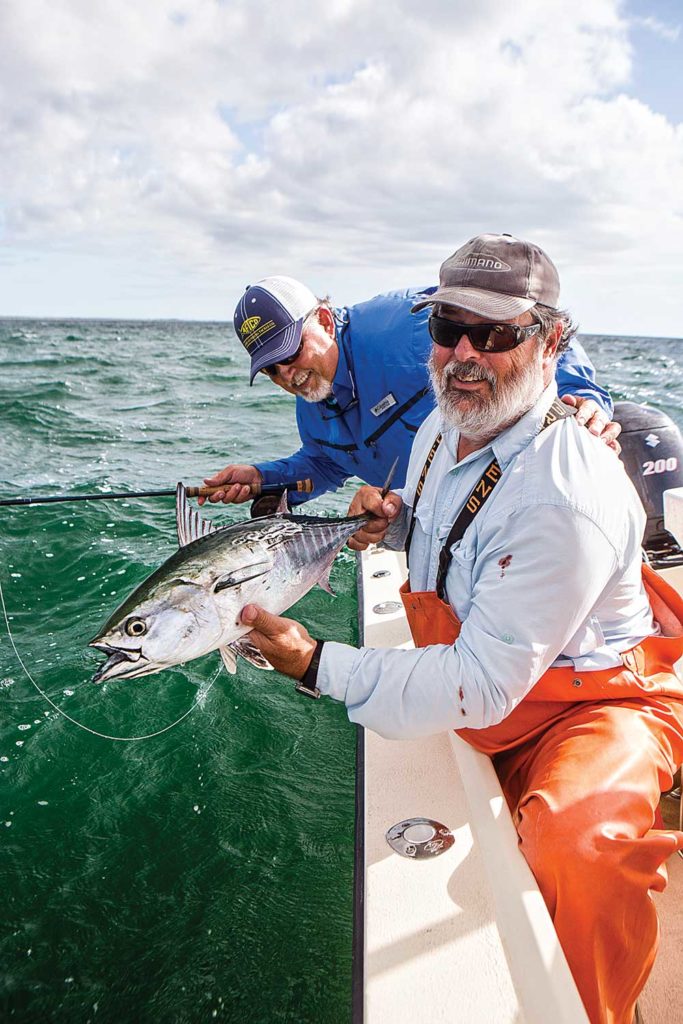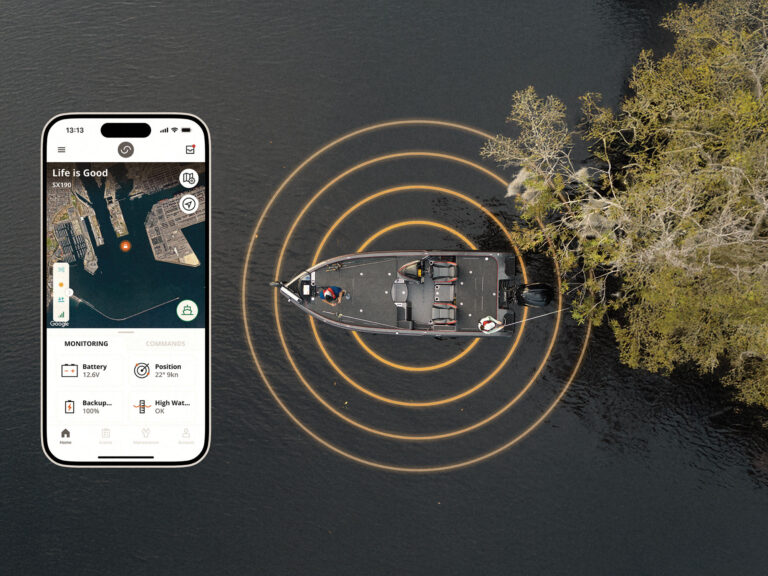
The annual summer arrival of Atlantic bonito (mostly called “bonito” or “bonita” for short) and little tunny (often called “albies,” “fat alberts,” or “false albacore”) never fails to create pandemonium in the waters of southern New England. From August to mid-October, the average boater is likely to encounter fast-moving pods of these fish churning the inshore waters south of Cape Cod, pursued by equally fast-moving pods of fishermen, most of whom will be screaming, shouting and seething over their inability to hook up.
Indeed, many anglers find themselves reduced to apoplexy in the face of these selective and keen-eyed members of the Scombridae family. But it doesn’t have to be that way, as the three experts in this article will tell you. While each may approach the art of catching bonito and albies a bit differently, their collective advice is sure to improve your score this season, no matter what part of the Northeast you fish. Here’s what they have to say.
Fishing Cape Cod for Bonito and Albies
Although he cut his teeth on stripers and bluefish on the south shore of Massachusetts, angler Mark Budreski’s passion is chasing bonito and false albacore in the waters off Cape Cod and Martha’s Vineyard from August to October. He trailers to different spots on the Cape depending on where the action is hottest, Mark has discovered that success in this fast-paced game often hinges on preparedness.
Therefore, he stresses the importance of “de-bugging” your tackle before you hit the water. “Get prepared at home,” he says. “Have your equipment cleaned and ready. Make sure you have fresh leader material. Make sure your reel is lubed, your fly line is straightened, and your hooks are sharp.” Of particular importance is a fine-tuned, silky-smooth drag to handle the fish’s lightning runs. “If your line encounters the slightest resistance, you’ll pop them off for sure,” he warns.
Another important part of Mark’s pre-trip routine is research. For example, he relies heavily on his network of fishing friends, as well as the internet, to help him zero in on when and where to launch. However, he also knows that both bonito and albies tend to “stage a repeat performance” by showing up in predictable locations year after year. Therefore, he maintains a mental list of hot spots he can rely on when recent reports of the fish’s whereabouts are lacking. Mark adds that tide and wind often influence which sites he’ll visit on a particular day.
“Different spots produce better on different tides,” he explains. “You’ve got to do your homework. Scout around and it will pay off. Observation is key. You have to see how the fish behave in different weather conditions. For example, the fish often go crazy when the water is kicked up by wind. They tend to be much more aggressive.”
Once he’s on the water, Budreski focuses on what he calls “edges.” “Albies and bonito are creatures of the edge,” he says. “They take advantage of the existing environment, using structure to corral baitfish. Therefore, I like to fish the edge of rocks, beaches, drop-offs — any change in structure that gives the fish an advantage over their prey. Prime spots include jetties, pond openings, rips, and beaches with access to deep water and current.”
On the days when the fish aren’t showing on top in his chosen spots, Mark often resorts to blind-casting. “When you don’t see anything, do a little prospecting,” he advises. “The main thing is to have your fly or lure in the water for the maximum amount of time.” If you know fish are likely to be in the area, Mark suggests rigging up a deep-sinking line or letting your spoon or jig sink a little longer; you might just pick up a single fish that’s cruising the depths.
Because albies and bonito can be very selective at times, it sometimes takes a while to discover what combination of depth, lure or fly, and retrieve will get them to eat. That’s where two anglers are better than one. “Fishing with a partner is key,” he adds. “Having two people casting different flies, lures or fly lines will cut the experiment time in half. It will double your chances of catching fish and make it easier to figure out what they are taking.”
While many anglers believe that albies and bonito don’t begin feeding until the sun is well above the horizon, Mark is usually on the water before dawn. “I’ve never caught an albie after sunset,” he says, “but I have done very well right before sun-up,” he says. Not only does this early start account for some excellent action, it also means that Mark doesn’t have to compete with other fishermen.
Unfortunately, competition is usually a given in the crowded inshore waters of southern Massachusetts, and it doesn’t take long for a small pod of breaking fish to attract the attention of a half-dozen boats. Mark’s advice in this situation is to stay calm. “When you start chasing the schools around, you start spazzing, and when you start spazzing you make mistakes. There are just too many things moving around at once.”
To escape the pandemonium of the typical bonito or albie “rodeo,” Mark often anchors in a prime location where the fish have been appearing regularly. This strategy lets him concentrate on making long casts and careful retrieves. By methodically working the area and waiting for the fish to swim past his position, he often out-catches the school-chasers. He points out, however, that anchoring is taboo in areas where other boats are making repeated drifts. In this case it’s best to join the line of drifting boats.
Above all, Mark is a patient fisherman who takes the time to explore each spot thoroughly before moving elsewhere. He says that too many anglers leave a productive area just because they don’t see fish busting on the surface. “The grass is always greener,” he laughs. “But if you put in your time at each spot before moving, you may be pleasantly surprised.”
The Vineyarder
Another expert at catching bonito and false albacore off southern Massachusetts is Captain Leslie Smith of Martha’s Vineyard. During the late summer and fall, you’ll find Leslie and her customers tracking down tuna in her 26-foot Regulator, Backlash. A two-time albie record-holder herself, Smith says that baitfish are one key to locating the action. “You’re not going to find the fish unless you find the bait,” she states, adding that wind direction can have a major influence on the presence of both. “If the wind is blowing from one direction, the bait’s going to pile up on the windward shore. And eventually the fish are going to find that bait.”
Once Leslie finds the fish, she usually prefers to set up a drift through the hot zone. “I hate anchoring,” she says. “I’ll rarely anchor unless there are so many boats already anchored in a spot that drifting through them causes problems. If I have enough room, I’ll always drift.”
Like Budreski, Smith points out that albies and bonito will often make a circuit along a rip line or section of beach, popping up in predictable spots. “A lot of times the fish will establish a pattern, allowing you to stay with them. For instance, off Cape Pogue on an incoming tide, the albies will often work their way along the beach and into The Gut. You can follow those fish as they move down the beach. Make a drift through the area, then circle back around and start another drift.” Smith stresses how important it is for everyone in the fleet to follow the drifting strategy in order for it to work. In other words, if everyone else is drifting, don’t anchor in the middle of the drift zone, and resist the urge to fire up your engine every time a school pops up nearby.
Weather can have a profound effect on the behavior of bonito and albies. While calm, bright days can produce some excellent fishing, that doesn’t mean you should stay in bed when conditions deteriorate. In fact, really ugly weather can produce some epic bites. “When it’s rougher than hell, the albies can be a lot easier to catch,” she says, adding that her clients have enjoyed some phenomenal fishing with spinning gear when it has been too rough to throw flies.
Albies feed much earlier and later than many anglers believe. This one was taken during a late-afternoon bite.|
Leslie’s go-to lure on spinning tackle is a one-ounce, bullet-head jig with natural bucktail. “I almost always start out with the jig,” she says. “If that doesn’t work, I’ll try little metal spoons such as Deadly Dicks and the like.” She also points out that white is a good choice for flies in the early morning.
For spinning gear, Leslie prefers ten-pound test and lighter. Fly tackle, on the other hand, demands slightly heavier tippets due to line drag. “I wouldn’t use anything lighter than ten-pound tippet for bonito,” she says. “And I’d go a little heavier with albies because the drag of the fly line when the fish takes off will often break the tippet.” She also advocates the use of fluorocarbon for tippets and leaders, feeling that it can make the difference in getting fussy fish to bite in certain conditions.
Another item that can save the day when the fish are spooky or hard to find is chum, although Leslie doesn’t use it very often. “I’ve tried it on occasion,” she says. “For example, I’ve anchored up when the fish were real scattered and dropped over some chopped-up butterfish we had left over from offshore tuna fishing. It does work.” She adds that the dry chum used by some offshore anglers can also draw albies to the boat.
When asked to comment on the subject of albie and bonito etiquette, Leslie groans. “Don’t get me started,” she laughs, then fires off a list of good advice for every angler to follow. “Don’t run over the fish. Turn your engine off when fishing (engine noise spooks the fish). When the fish are real tight to the beach, don’t crowd the shore fishermen; they have a hard enough time as it is.”
Leslie admits that she isn’t shy about confronting the “less-informed” anglers. “If some bozo comes blasting in, putting the fish down, I’ll go over and try to explain the program to him. It doesn’t always work – I’ve gotten the finger a few times – but it’s worth a try.”
The Connecticut Connection
Eric Peterson is the owner/proprietor of the Fairfield Fly Shop and a man who has spend a lot of time pursuing false albacore and bonito in the waters of Connecticut. When it comes to tracking down the tiny tuna, he says current is key. “All the spots that produce, whether it’s a creek mouth or beach, have significant tidal movement. That’s a key factor in locating them.”
When asked about the best tides, Eric says that both the ebb and flood produce well, but feels that the former holds a slight advantage. “We have a very shallow shelf along the Connecticut coast,” he explains. “As water starts to fall off the flats, the fish will gather along the sand bars to pick off baitfish.”
Like Budreski and Smith, Peterson often waits to see if the fish are running a circuit along the shore or a rip line. “Blind-fishing is pretty tough, and I would advise against the run-and-gun approach. The best thing to do is watch for some sort of pattern to develop. If they popped up in one spot there’s a reason why they did, and there’s a good chance they’ll come back. Your best bet is to find a place where they’ve just showed and wait it out. If you try to chase them, you’re not going to catch up with them, and you’ll only break their cycle. If they’re up and they’re moving, you’ve got to get way in front of them and hope they come within range.”
Eric says that autumn can produce some excellent action along the Connecticut coast, but that weather can play a crucial role. “In the fall, I want consistency and stability in the weather, with a nice light to moderate northwest wind. As far as sunlight is concerned, I don’t think it makes a difference. I’ve enjoyed some awfully fine fishing on bluebird days. When the weather really turns snotty along the Connecticut coast, the shallow inshore water gets too roiled, and you’re not going to catch anything along the beaches.”
Eric points out that imitating the fish’s natural forage can be extremely important to success. “It really helps to have an idea of what the fish are eating. Here in Connecticut, there are three likely candidates: silversides, sand eels and baby bunker (juvenile menhaden).
According to Peterson, more often than not the fish will be feeding on silversides, which is why he has had so much success with an epoxy Surf Candy fly. “If I had no prior knowledge of what the fish were eating, I’d choose a silverside pattern. In fact, I’ve caught fish on the Surf Candy even when they were feeding on other types of bait.”
Don’t throw in the towel if you don’t see fish busting on the surface. Elizabeth Lloyd caught her first albie with Matt Koenig by blind-casting near the entrance to Menemsha Harbor on Martha’s Vineyard.|
Although spoons and jigs take their share of Connecticut fish, Eric says that they can’t come close to flies when it comes to imitating the size, translucency and movement of a real baitfish. Fortunately, flies can also be fished on spinning gear with the aid of a dropper loop (see “Summer Schoolie Solution,” July 2000, SWS). Simply tie a dropper loop in the line ahead of a jig or spoon, then attach a fly of your choice to the loop. “It’s almost too damn easy doing it that way,” chuckles Eric.
Because presentation is a major key to success, Eric always uses a Duncan loop knot, which allows the fly to move more freely as it swims. “Use a loop knot and you’re going to catch more fish,” he states.
On the subject of retrieves, Peterson has some definite advice. “Go against the common belief that you have to strip the fly as fast as you can. I catch more fish by dead-drifting the fly than by stripping it. Remember, a sand eel or silverside can’t swim as fast as an albie. Strip the fly and let it sit. Also, you want the lure or fly to be traveling in the same direction as the bait.”
When chasing fish through open water, Eric points out that being able to react quickly is of paramount importance. “You’ve gotta make a guess as to which direction they’re moving, and you have to react. If you stand there and think, you’re dead, because many times you only have a second to make the cast. A lot of this stuff is really hard to teach someone because instinct plays a big part. The reason I know everything I know is because I’ve tried the wrong thing and failed.”









